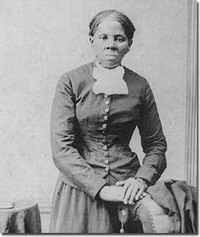Login form
Harriet Tubman

Who was the most famous “conductor” on the Underground Railroad? That was Harriet Tubman. She rescued at least 300 people from slavery in the 1850s.
BORN A SLAVE
Harriet was born a slave on a plantation in Maryland. When she was 5 years old, she started working as a maid. At 12, she went to work in the fields. As a young woman, Harriet had to ask her master’s permission to marry John Tubman. John was a free black man.
ESCAPE TO FREEDOM
After getting married, Tubman continued working as a slave. Her master died in the late 1840s. She was afraid she would be sold to a plantation far from her family. So in 1849, she escaped to Pennsylvania.
At that time, Pennsylvania was a free state, which meant that it did not allow slavery. In many free states, people called abolitionists were trying to end slavery. After escaping to Pennsylvania, Harriet became an abolitionist.
THE UNDERGROUND RAILROAD
The Underground Railroad wasn’t a real railroad at all. It was a network, or group, of abolitionists who helped slaves escape from the slave states of the American South. It was called a “railroad” because the abolitionists were spread all along the route that slaves traveled to escape. It was called “underground” because they had to travel in secret. Otherwise, they might be caught and sent back to their masters, who could punish them for trying to escape.
Harriet Tubman was a “conductor” on the railroad. This meant that she traveled from the North to the South to get slaves and lead them to freedom. She made her first trips along the Underground Railroad to Maryland. She helped her sister and her elderly parents escape to Pennsylvania. In all, Tubman made 19 trips as a conductor on the Underground Railroad.
Slave owners hated Harriet Tubman. They offered $40,000 for her capture.
HOW DID SHE DO IT?
To keep the slave owners from catching her, Tubman wore disguises on her trips. Sometimes, she dressed as an old man. Other times, she pretended to be an old woman. She also changed her travel routes to throw off anyone trying to follow her.
The trips were very dangerous. Sometimes the slaves were so afraid that they wanted to turn back. But Tubman always pushed on. None of the slaves traveling with Tubman were captured during their escape.
AFTER THE RAILROAD
Tubman went on to help other abolitionists. She helped John Brown plan his famous rebellion at Harpers Ferry, Virginia (now West Virginia), in 1859. She had planned to go with him, but illness kept her home. The rebellion went terribly wrong, and United States soldiers captured Brown and his followers.
After the Civil War started, Tubman followed a regiment of black Union soldiers to Florida and South Carolina. She went into enemy territory to spy on the Confederate Army and to encourage slaves to run away. Tubman also worked as a nurse tending wounded Union soldiers.
When the war ended, Tubman returned to her home in Auburn, New York. She was poor, but she raised money to help former slaves. She also promoted the rights of women, especially black women. She fought for women to be able to vote. Tubman worked to help others until she died in 1913.
In 1978, the U.S. Postal Service issued a stamp honoring Harriet Tubman. Today, her home is a national historic landmark.
Source: Microsoft ® Encarta

